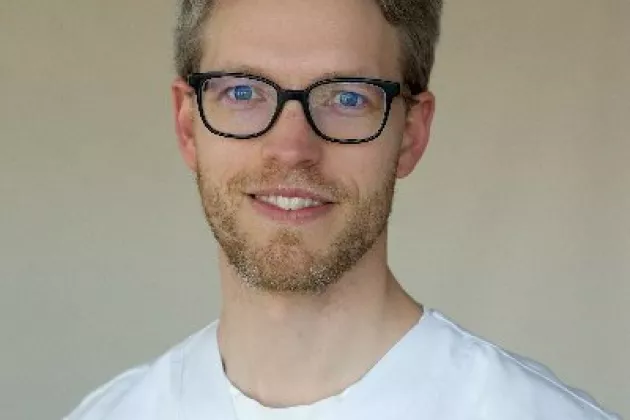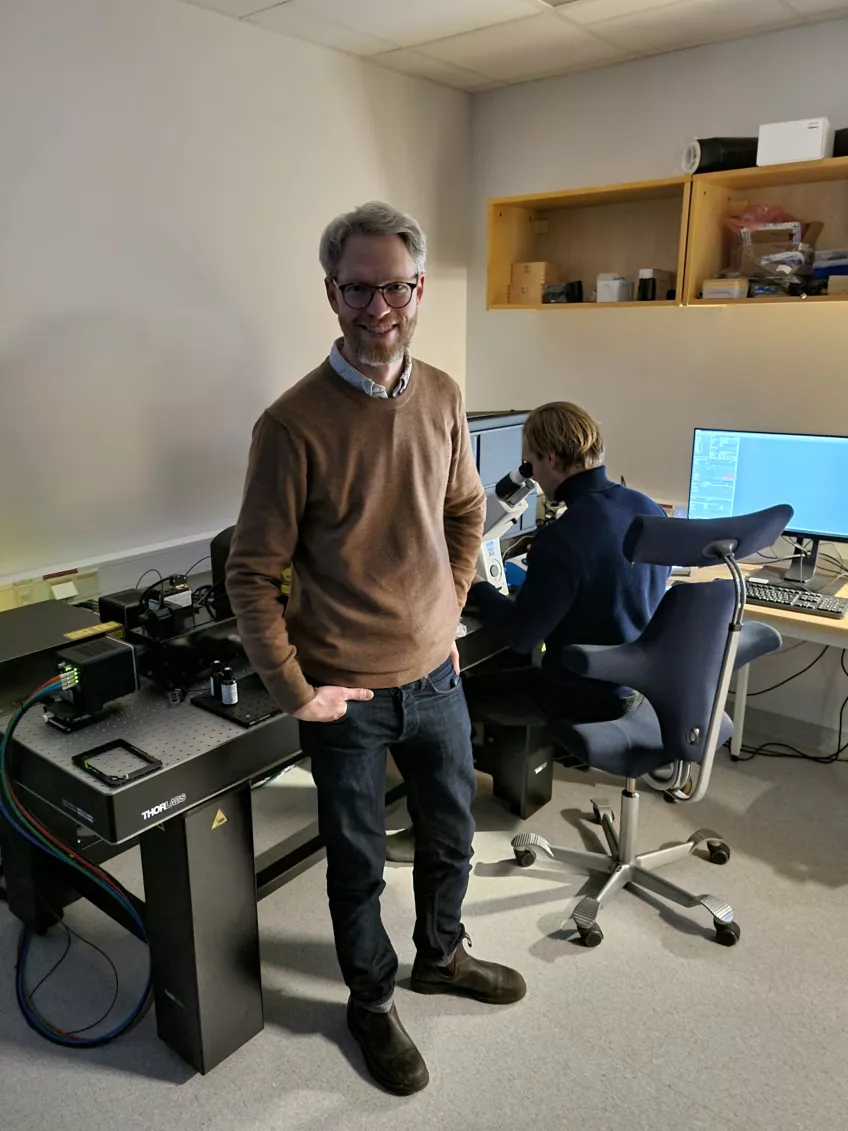To tackle delivery, Anders mentions that endosomal escape of RNA is crucial. Endosomal escape refers to the difficulty of releasing uptaken RNA molecules from the endosome into the cytosol. RNA that is not released can hardly elicit any therapeutic effectiveness. Anders highlights the general challenge of delivering nucleic acid-based drugs, such as DNA and RNA, due to inefficient escape from endosomes. The goal is to enhance this escape process. Moreover, Anders expresses a specific interest in developing methods to detect, visualize, and measure the efficiency of nucleic acid delivery into cells.
"It's relatively easy to get things into endosomes such as large molecules, but it's very tricky to get them out of endosomes. That's the step we want to improve. And then we have an even more specific interest in developing methods to detect, visualize and measure delivery."
In our conversation Anders touches upon different strategies for administering nucleic acids, such as using lipid nanoparticles (similar to those employed in the COVID vaccines). These can be administered intravenously after which they end up mostly in the liver. On the other hand, a ligand can be put on the particles that is recognized by a surface receptor of specific tissue for targeted delivery. Another problem of RNA delivery is that such approaches require modifying the RNA for stability to avoid being broken down by RNAses and achieve prolonged therapeutic effects. Anders mentions how fast RNA is generally degraded: "You can modify the RNA so that it is very stable and not broken down by RNAses. This is generally a problem, as you see, the half life of natural RNA in the circulation is in seconds or minutes."
Anders provided examples of RNA therapeutics, including addressing genetic diseases such as amyloidosis by turning off the production of aberrant proteins by small interfering RNAs (siRNAs). In other examples, RNA is used for delivery of CRISPR-Cas9 and prime editors, showcasing the potential for rewriting the genetic information. Besides stability of RNA, however, the delivery efficiency is another limitation. While the liver is easily targetable, other tissues such as tumors are challenging. Challenges in delivering RNA therapeutics to tumors are currently explored extensively and some of the reasons are poor circulation in the tumor and tight endothelial barriers preventing penetration. Especially, if RNA therapeutics need to be delivered to the vast majority of tumor cells, the formulations require good penetration of the tumor tissue. But this is not exclusively valid for tumor tissues, as most tissues have a very tight endothelium. "There is the same issue with most tissues in the body. As most tissues have a very tight endothelium, you have difficulties getting larger things out there."
We then asked how tumors can be specifically targeted and Anders mentioned using RNA conjugated to cholesterol as a method to target rapidly dividing cells in tumors. "With specific receptors, you have the risk that not the whole tumor will have this specific receptor but other cells might have it. You also risk having mutational inactivation of the receptor if targeting involves a single, specific point at the receptor. We are using, in one of our model systems, RNA conjugated to cholesterol, which is a building block for dividing cells. So, it's very difficult for cells to escape that."
Anders emphasised the lab's focus on fine-tuning methods and developing techniques to visualize and understand the barriers and inefficiencies in the process of RNA delivery, rather than creating treatments directly. One of the biggest challenges are understanding the way of overcoming this delivery inefficiencies. Developing a platform to overcome these barriers can then be widely used for the development of a variety of RNA therapeutics.
"We are very focused on developing methods to visualize the details of delivery as a way of understanding where the barriers are. How can we identify the specific inefficiencies in the process? How many molecules are getting into the cells? That's our focus. This is not exclusive for cancer, but it's quite attractive too for other diseases as well."
Anders is collaborating with AstraZeneca in the development of techniques to measure delivery efficiency. He developed a key technique during his postdoc at the Harvard Medical School in Boston, USA. "We discovered that you could use an endogenous sensor for endosomal membrane damage that all our cells have. Cells have proteins that react when an endosome is damaged, because that's a sign for the cell that something or someone is trying to get into their precious cytosol." These sensors were discovered through bacteria that tried to get into the cells and are now employed to monitor the extent of endosomal damage caused by lipid nanoparticles. Nowadays, pharmaceutical companies utilize these techniques to allow real-time monitoring of the delivery process by microscopy.
Anders Wittrups' interest in gene therapies sparked during early encounters with a scientist, who highlighted the significance of genes in our genome that are not coding for proteins. These genes produce microRNAs, which, when introduced into cells as double-stranded short RNAs, can turn off specific genes called siRNAs. "There are thousands of these genes, and they are evolutionary conserved, and no one knew what they were doing". During his PhD with siRNAs, Anders became more aware that endosomal escape was the rate limiting step for delivery. He found a group in Boston, which worked in the same field and he contacted principal investigator Judy Lieberman for a postdoctoral position. Judy Lieberman was also affiliated with a company pioneering siRNA compounds with lipid nanoparticles. During his postdoc, Anders' aim was to develop a microscopic method to visualize endosomal escape. Further exploration led to the identification of galectins, a protein sensor used to detect endosomal escape.
Anders emphasized how proud he is to have put together a good team in Lund, that despite his halftime work in the clinic, became world-leading in detecting and visualizing endosomal escape of RNA. Anders has three PhD students, two postdocs, and a part time technician. He also mentions the difficulties in the beginning. "When I was starting up the lab here, I thought that we would be killed, scientifically, by a lot of other big groups and companies and so on, but it is not extremely simple for anyone else to jump in on the topic. You need to have quite solid microscopy experience, and the right hardware tools, which we have now. And you also need to be into the therapeutics aspects." Anders' lab is focuses on translational science. The tools they are using and developing are used by both pharma and and academic labs. "We get a lot of interest from pharma companies to do various forms of analysis, which we have not been doing so far, because we are not that interested in being a service. But we could do this."
"Being part of WCMM was instrumental for two aspects", Anders says. The first aspect was of financial nature since it provided the means via a starting grant to recruit people and set up a lab. But with regards to the other aspect, Anders says "for me, the network has been really important, especially since I'm in the clinic at halftime and then to have a forum for interaction with other clinical researchers and also basic scientists inspired and helped me by discussing how they organize their labs, how to find good people, what avenues they are pursuing and to get ideas. Especially with Vinay (Swaminathan), with whom we are sharing also microscopy techniques."
Clinically, Anders is specialized on brain tumors and his first aim to improve nucleic acid delivery is based on brain tumor models. Highly malignant brain tumors, such as glioblastoma are currently not efficiently treated, but the location of these tumors in a closed system within the skull makes RNA delivery an interesting tool, since it can be applied locally rather than systemically. "The drug will not diffuse away and can be combined with targeting dividing cells." However, Anders also emphasizes that we are still at the basic science level and there is still more time needed to develop those therapeutics.
As an outlook, Anders told us that there are two main avenues his lab pursues. One focuses on developing more clever strategies for delivering nucleic acids to tissues and the other avenue is to go into detail what happens when the molecule is delivered. "I want to go as deep down into the molecules as possible, higher resolution, higher temporal resolution, tracking individual molecules, orientation of the molecules. With these strategies unexpected things have turned up so far, and I think that will continue to do so."
For such discoveries, Anders mentions how important it is to have the right equipment. He received an equipment grant from the Fru Berta Kamprad Foundation in May 2022 and after a long evaluation decided to purchase a high-speed instant structured illumination microscope (iSIM), which can generate 3D + time super-resolved images using conventional fluorescent dyes and molecules and allows the precise analysis of sub-diffraction limited dynamic processes within cells and tissues. It took a few months to get the systems in place. One system is a state-of-the art Zeiss confocal system with integrated software and analysis tools. "The system is super polished with loads of highly usable tools and bleeding edge performance. The system is very adaptable to most researchers needs, a real swiss army knife. And then we have this other system. That is almost my baby, which is not as integrated. We've gotten different components from different suppliers. There was one company that is responsible for the main components and took care of the whole integration and installation. But still, there is a little bit more development of the analysis pipeline and how we want to use it. So that took a few months, I would say, to really nail everything."
This system is one of only a few worldwide and possesses specific characteristics that are advantageous. It offers as high resolution as other top confocal microscopy systems while excelling in speed, making it ideal for capturing rapidly occurring processes. Equipped with two separate camera detectors, the system can image two different channels or four different colors simultaneously. The speed allows for imaging including unconventional color combinations. The system uniquely balances spatial and temporal resolution, overcoming the typical trade-off in other techniques. While more sophisticated systems exist, this setup suits specific interests, offering a balance of functionality and user-friendliness for the research objectives. Overall, the system's combination of high resolution and speed makes it a valuable tool for studying diverse and fast-moving phenomena within cells.
At the end of our fourth WCMM Fireside Chat we would like to express our gratitude to Anders Wittrup for providing us valuable insights into the field of nucleic acid therapeutics and shared his experiences and specific interests, which really underscore his commitment to advancing RNA methodologies and therapeutics. Anders' team is motivated to bring the field to new heights, particularly focusing on refining the delivery of RNA therapeutics for cancer treatments. The WCMM Fireside Chat not only shed light on the current challenges and strategies in the field of RNA therapeutics but also emphasized the pivotal role of enhancing the delivery process. All the best for the future to you Anders and your team!



